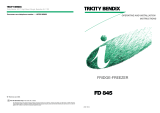
10
IE
Tips for refrigerating and
freezing food
Refrigeration tips
– To make sure that food in the fridge compart-
ment stays fresh and tasty, only put packed
food in the fridge compartment. Use special
plastic food containers or commonly available
foil.
– Let hot food cool down before placing it in the
fridge compartment.
– Place the food in the fridge compartment so
that the air can circulate freely. Do not cover
the shelves with paper or any similar material.
– Do not put the food directly against the rear
wall as it might then freeze onto the rear wall.
– Place a fridge thermometer on the glass panel
over the vegetable drawer so that you can
check that the temperature is right. The opti-
mum temperature is approx. +6 °C.
– Fruit and vegetables: put fresh fruit and veg-
etables in the vegetable drawer.
– The temperature is the lowest on the glass
plate over the vegetable drawer. This is good
for fresh meat, game, poultry, bacon, sausages
or raw fish.
– The temperature is the highest in the upper
zones and in the door racks; this is good for
cheese and spreadable butter.
– Bottles, drinks cartons: put bottles and drinks
cartons in the bottle rack in the door. Place full
bottles or cartons close to the hinges so that
they are not overburdened.
Freezing / storing tips
Please observe the following points to maintain
the flavour and the nutritional value of your fro-
zen food, to prevent your appliance from using too
much electricity and the freezer compartment from
having to be defrosted too frequently:
– Frozen food requires an even storage tempera-
ture of –18 °C.
– A maximum of 2.5 kg of fresh food can be fro-
zen within 24 hours.
– Only freeze food of perfect quality that has
been prepared, portioned and packaged ap-
propriately.
– Ready meals should also be frozen in portion
sizes where possible. Small volumes are eas-
ier to freeze right through to the core. Further-
more freezing several small portions is more
economical than throwing away the remnants
of a portion which is too large.
– Freeze meat, poultry and fish raw, or after pre-
paring them, in suitable sizes for your house-
hold and thaw them again in the fridge when
you need them. Make sure that meat and other
products do not lie in the liquid produced dur-
ing thawing.
– Do not add salt or spices to fresh or cooked
dishes that you want to freeze. Unsalted frozen
food has a longer storage time.
– To prevent frozen food from dehydrating, taking
on another product's flavour or running, use
resistant packaging material, i.e. air and liquid
tight, not too rigid, easy to seal and to mark.
– Observe the producer's instructions when stor-
ing ready frozen food.
– Observe the recommended storage times and
temperatures. The symbols in the door of the
freezer compartment provide a summary of
maximum storage times:
Fish, pastry and ice cream max. 2 months•
Milk and cheese max. 3 months•
Lamb, bread and game (packed in foil) max. •
4 months
Carrots, tomatoes, shellfish (shrimps, cray-•
fish, squid, mussels without their shells) and
food that has already been cooked max. 6
months
Fruit cake, sealed cheese max. 8 months•
Whole chicken, goose or duck max. 10 •
months
Mushrooms, steak and cauliflower max. 12 •
months
– Make sure that when storing fresh food it does
not touch already frozen food, as this might
cause the latter to thaw.
– Allow hot food to cool down before freezing.
This will not only save energy, but it will also
prevent excessive frost from forming in the
freezer compartment.



















